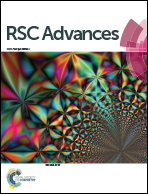Towards free-standing MoS2 nanosheet electrocatalysts supported and enhanced by N-doped CNT–graphene foam for hydrogen evolution reaction†
Abstract
Large-scale free-standing porous carbon-based catalyst supports are critically needed for the hydrogen evolution reaction (HER) in view of their practical application. In this work, MoS2 nanosheets were uniformly deposited onto N-doped carbon nanotube–graphene (N-CNT–G) hybrids, forming a three-dimensional (3D) free-standing architecture. The designed 3D hybrid materials exposed the MoS2 nanosheet catalyst on the one-dimensional CNTs and there was facilitated ion transportation because of the porous graphene foam, and these 3D hybrid materials were used as electrocatalysts for HER directly without any transferring process. Moreover, N doping decreased the overpotential to 0.08 V, which increased the stability and promoted the catalytic activity, providing a facile route to design advanced high-performance HER catalysts towards a free-standing configuration.


 Please wait while we load your content...
Please wait while we load your content...